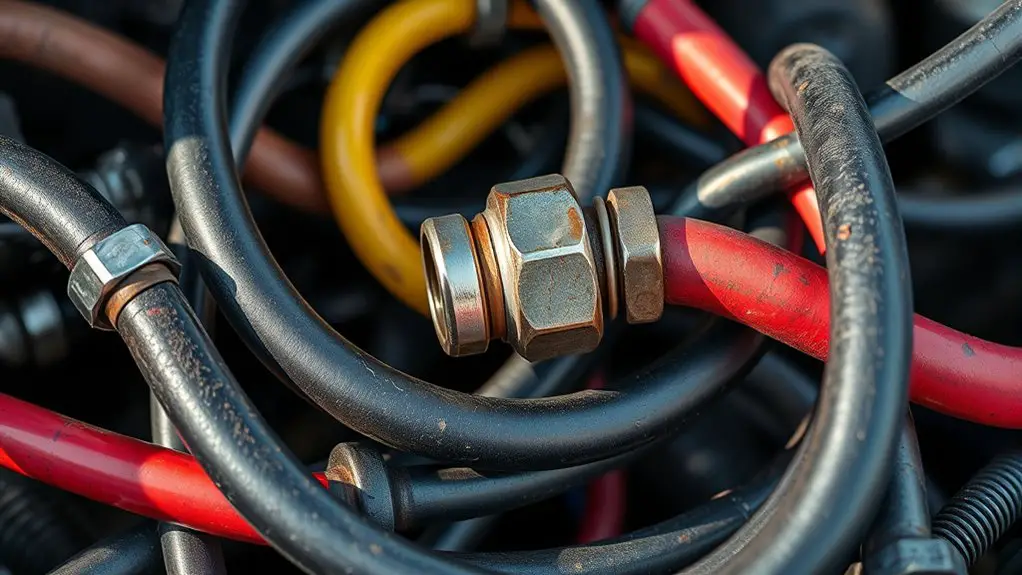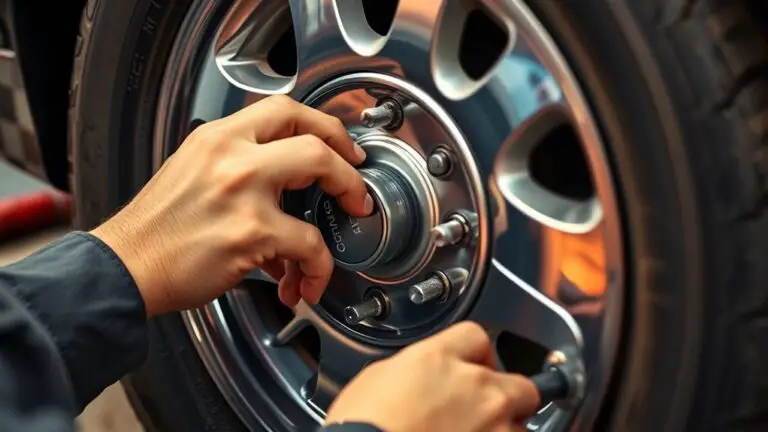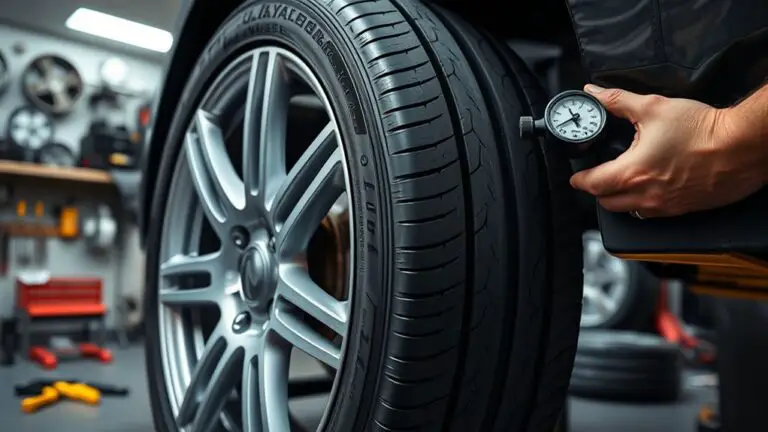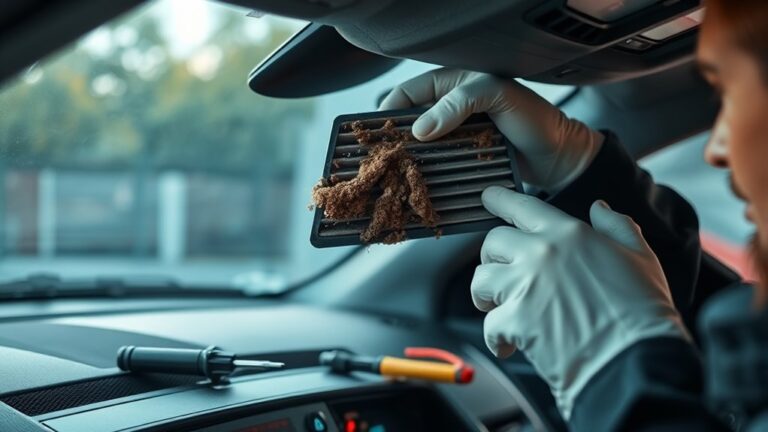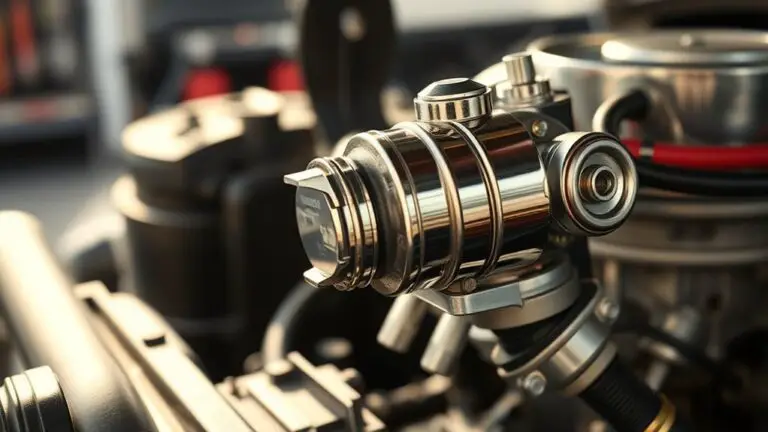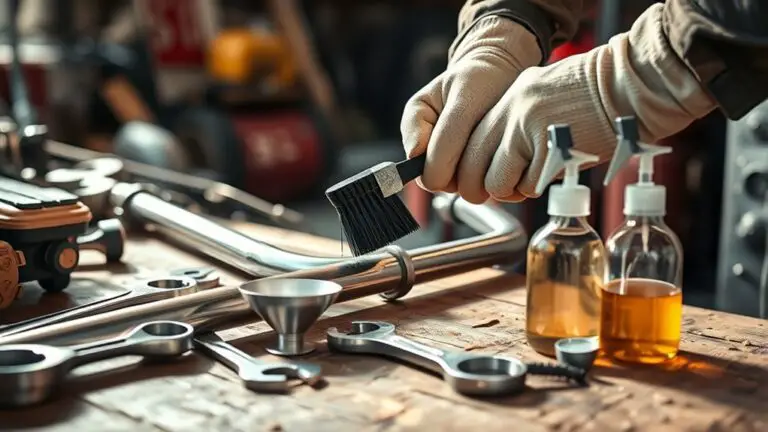Common Mistakes When Installing Hydraulic Hoses
You’ll avoid costly failures if you rigorously select the correct hose size, verify pressure and temperature ratings, and guarantee all fittings and routing meet strict compatibility and safety standards. Don’t guess hose length or end fittings—document diameters and thread standards before purchase. Never mix hose types or connectors, and maintain proper routing with adequate bending radii. Cleanliness, contamination control, and thorough testing are essential. If you keep going, you’ll uncover more critical steps to protect your system.
Choosing the Wrong Hose Size
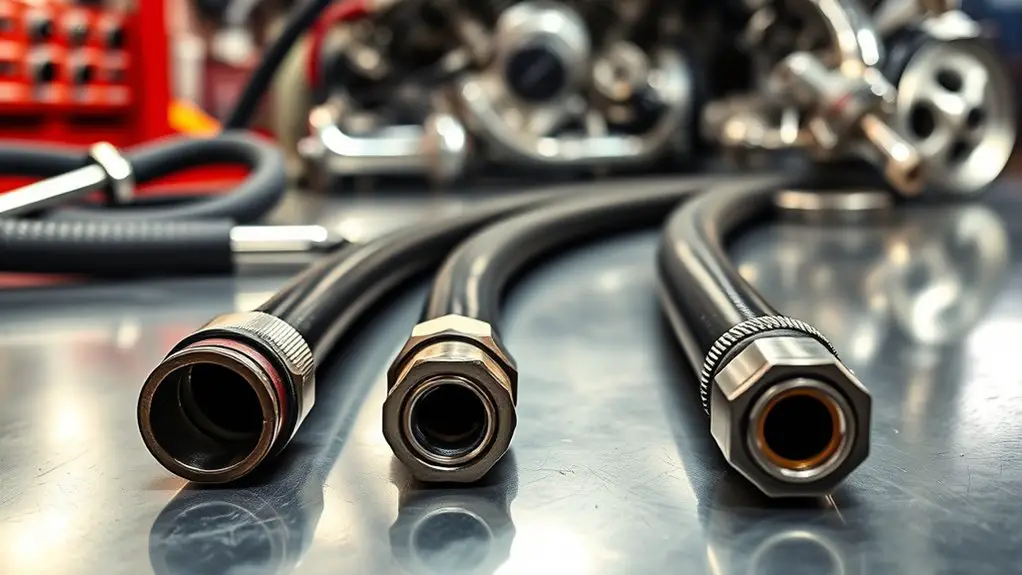
Choosing the wrong hose size is a common, avoidable mistake. To prevent it, you’ll verify hose length first, ensuring it matches your layout without excess slack. Measure from supply port to connection point, including any bends, and account for movement during operation. Next, confirm fitting types at both ends and confirm compatibility with the system’s quick-connects or threaded adapters. Mismatches here cause leaks, pressure loss, and truncated performance, so document each end’s diameter and thread standard before purchase. Consider the operating pressure, temperature range, and flow requirements; a size too large can waste torque capacity, while too small raises heat and wear. Anticipate future needs, like additional length or alternate configurations, and choose a hose with flexible, durable walls suited to the ambient environment. Select a reputable manufacturer, request exact part numbers, and keep a precise record for maintenance. Your careful choices protect performance, safety, and long-term freedom to adapt.
Ignoring Pressure and Temperature Ratings
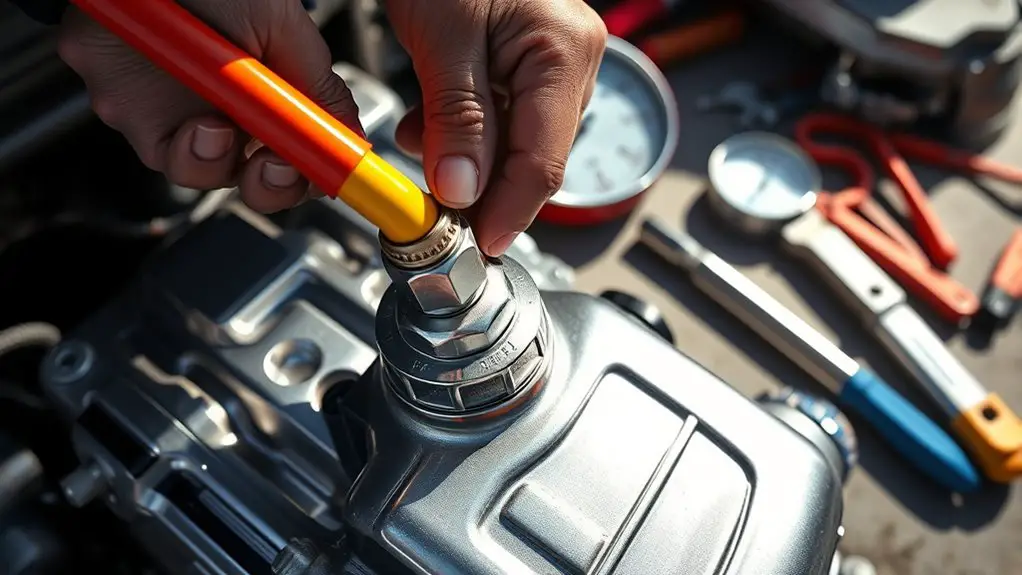
You must verify both pressure and temperature ratings for every hose and fitting you install. Mismatches in rating can lead to premature failure, leaks, or catastrophic bursts, so check the spec sheets and labels before connecting anything. Remember the temp-pressure limits and plan for peak operating conditions to avoid hidden compatibility issues.
Rating Mismatch Issues
Rating mismatches occur when hoses or assemblies are specified beyond or below the system’s actual pressure and temperature conditions. You’ll encounter unexpected failures if you choose components that don’t align with the required rating standards and performance metrics. Before selecting parts, verify the system’s operating range, including peak pressures, surge margins, and ambient conditions. Documented specifications should match the hose’s ratings, not merely assumptions. If you’re uncertain, consult manufacturer data and cross-reference with applicable standards. Don’t rely on appearance or cost as a proxy for capability. A precise, methodical check reduces risk of leaks, ruptures, and downtime. Maintain a clear audit trail, so replacements align with real service needs, preserve safety, and honor your commitment to dependable, freedom‑driven operation.
Temp-Pressure Limits
Temp-Pressure limits demand you acknowledge that both factors independently constrain hose performance; ignoring either can mask failure risks. You must check ratings for pressure and temperature separately, not as a single vague comfort zone. Temperature fluctuations affect material strength, insulation, and flex life, while pressure spikes threaten immediate rupture and long-term seam creep. Decide if your hose design tolerates peak loads and ambient swings, then verify with manufacturer charts and your system’s duty cycle. Don’t assume a cool-off period or steady heat will keep margins safe; both extremes can bite unexpectedly. Document-rated ranges, monitor real-time conditions, and select hoses with appropriate derating. When in doubt, choose a higher safety factor and prioritize predictable operation over marginal gains. Freedom here means refusing risky compromises.
Mixing Hose Types and Connectors
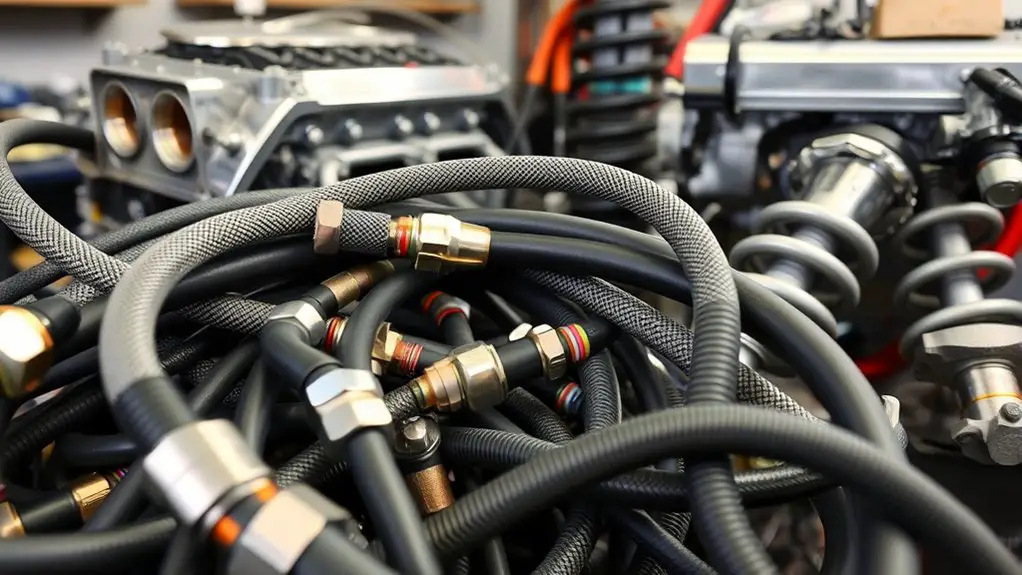
Mixing hose types and connectors can create weak points if the hose and connector aren’t compatible. Ascertain you match hose type to the correct connector and verify that their pressure ratings align. Incompatibility and mismatched ratings can lead to leaks, failures, or unsafe operating conditions.
Incompatible Hose-Connector
When hoses and connectors aren’t matched, leaks, burst hoses, or sudden failures can occur under pressure. You must respect hose compatibility and the intended connector types for any system you install. Before pairing components, verify material, thread standards, and end fittings, then cross-check against your hydraulic spec. Don’t assume a hose will fit a different connector simply because it looks similar; small mismatches can escalate under load. Keep a labeled, reconciled catalog of hose types and compatible connectors, and only use hardware rated for your pressure and temperature ranges. Handle assemblies with deliberate care, avoid forcing connections, and replace any damaged seals or ferrules. Thoughtful selection minimizes risk, preserves performance, and supports safe, flexible operation across varied tasks.
Matching Pressure Ratings
Matching pressure ratings requires careful pairing: use hoses and connectors whose rated pressures align or exceed the system’s maximum. You’ll verify each component’s rating against the circuit’s pressure differential, ensuring no part risks overpressure. Avoid mixing low-pressure hoses with high-demand connectors, or vice versa, since mismatch fosters abrupt failure and unpredictable behavior. Catalog every hose type and fitting by their pressure rating, temperature range, and compatibility with your fluid. When selecting, prefer assemblies with a single, clearly stamped maximum rating rather than ad hoc substitutions. Document the limits and inspect for wear that could escalate hose fatigue over time. Stay vigilant for deformations, abrasions, or softened areas after routing. Precision in matching ratings protects performance, personnel, and freedom to work confidently.
Improper Routing and Bending Radius
Improper routing and bending radius can create undue stress on hydraulic hoses, leading to premature wear, kinking, or failure. You must plan routes that avoid sharp corners, excessive bends, and pinch points. Maintain ample slack to absorb movement, yet secure hoses to prevent fatigue from vibration or load shifts. Use the recommended bending radii for each hose size and media, and verify compatibility with fittings and connectors. Whenever routing, consider future maintenance and avoid crossing hot surfaces or moving parts that could abrade or heat the hose. Document routing guidelines and apply consistent practices across installations. Check clamps, supports, and guides for proper spacing, and replace damaged components promptly. Adhere to bending techniques that minimize coil memory and stress concentrations. Regularly inspe ct for wear, leaks, or misalignment, and retrain staff on safe handling.
| Route Safety | Bend Radius | Inspection Notes |
|---|---|---|
| Use guards | Follow specs | Record findings |
| Secureings | Smooth bends | Replace worn |
| Clean paths | Avoid fatigue | Schedule reviews |
Inadequate Cleaning and Contamination Control
Inadequate cleaning and contamination control can silently ruin hydraulic systems, so establish strict cleanliness protocols before, during, and after hose installation. You’ll protect performance by defining clear cleaning procedures and enforcing them at every work stage. Begin with controlled environments, removing debris and securing contaminants that can lodge in ports and fittings. Before you start, inventory tools and components; never reuse rags or wipes that carry grit. During handling, wear clean gloves and minimize touching sealing surfaces. When hoses are prepared, flush lines and inspect for foreign particles; document results to trace contamination sources or lapses. Seal unused ports to prevent airborne dust entry and keep storage areas tidy. Train everyone involved to recognize tiny contaminants and insist on repeatable, verifiable steps. By maintaining disciplined cleaning procedures and a constant eye on contamination sources, you preserve system integrity, reduce risk of leaks, and extend hose life without sacrificing efficiency or safety.
Skipping Fittings and Seal Compatibility Checks
Skipping fittings and seal compatibility checks can undermine system integrity, so always verify that every component matches the hose, port, and pressure rating before assembly. You verify fitting selection early, confirming thread type, size, and end connection against the hose assembly plan. Do not assume compatibility; inspect each interface for markings, tolerances, and supplier specifications. Check seal materials for chemical compatibility, temperature range, and hydraulic fluid compatibility, selecting a seal that maintains performance under load and cycling. Confirm that seals and gaskets align with port standards and that any O-rings, thread seals, or collar seals are rated for the operating pressure and temperature. Document the exact part numbers used and cross-check against the system diagram. If mismatches appear, halt assembly and source proper components. A disciplined, proactive approach prevents leaks, pressure spikes, and component failure. Prioritize clear, verifiable choices over expediency to sustain reliable, safe operation.
Inaccurate or Missing System Profiling
Inaccurate or missing system profiling undermines every subsequent step, especially after verifying fittings and seals. You approach this with a clear mindset: map the entire hydraulic system before selecting hoses, fittings, or routing paths. Start by documenting fluid type, operating pressure, temperature ranges, and duty cycles. Verify system compatibility across components, noting any mixed brands or legacy parts that could introduce compatibility risks. Confirm reservoir levels, return lines, and filtration stages to avoid unexpected contaminants or pressure spikes. Establish accurate flow directions, pressure zones, and potential thermal expansion points, then translate those findings into installation guidelines you can trust. Avoid assumptions; validate each parameter against manufacturer specifications and safety standards. This profiling becomes your baseline for sizing, routing, and securing hoses, preventing misfits and leaks. You gain freedom through disciplined preparation, ensuring that every connection aligns with the system’s real needs, not convenient shortcuts.
Insufficient Testing and Validation
Even so, without thorough testing and validation, you won’t know whether the hose assemblies perform under real operating conditions. You should adopt a disciplined approach: establish clear testing procedures, define acceptance criteria, and execute repeatable steps. Do not assume compatibility from labels or measurements alone; verify dynamic loads, temperature ranges, and pressure spikes that mirror your system’s duty cycle. Document each test scenario, including setup, instrumentation, and observed results, so you can trace any deviation to a specific input. Validation processes must cover material compatibility, fitting integrity, and hose length behavior under motion and vibration. Include leak checks, cycle counts, and pressure hold tests, then review outcomes against defined tolerances. If results reveal margin shortfalls, pause installation, adjust components, and retest. Maintain auditable records, assign responsible testers, and schedule periodic revalidation when system conditions change. This disciplined cadence supports safe performance and reinforces your freedom to operate with confidence.
Poor Maintenance and Reuse of Damaged Components
Poor maintenance and reuse of damaged components undermine safety and performance. You must resist the urge to reuse parts that show wear, cracking, or deformation. Instead, adopt a strict policy: replace suspect items, retire hoses beyond service life, and document every decision. Regular inspections drive early danger detection, while component evaluation confirms suitability before reuse. If a part fails even a little, discard it and review your process to prevent recurrence. Keep an organized catalog of approved replacements and maintain consistent labeling. Train operators to spot leaks, abrasion, and corrosion, and empower them to halt installation immediately. Maintain a fault tree that traces issues back to maintenance intervals and inspection findings, not assumptions. This disciplined approach protects crews and equipment, and it reflects a freedom to do the job right.
| Condition | Recommended action |
|---|---|
| Visible wear | Reject, replace |
| Leaks or seepage | Deprecate, test, replace |
Frequently Asked Questions
How Often Should Hydraulic Hoses Be Visually Inspected During Use?
You should inspect hydraulic hoses daily during use. Maintenance hinges on inspection frequency, with visual indicators guiding you to take action sooner rather than later. Look for cracks, gouges, blistering, leaks, or stiffened sections, and check fittings for looseness. If you notice any issues, stop operation and replace or repair immediately. Document findings, stay proactive, and maintain a routine. Your disciplined approach protects people, equipment, and productivity, while keeping you safely in control.
What Signs Indicate Hose Failure Beyond Visible Wear?
Signs of hose failure beyond visible wear include sudden pressure loss, alternating or reduced performance, and unusual noises or vibrations under load. You’ll also notice leaks, stiff or hard sections, and swelling at fittings. Watch for fluid contamination, including metallic or gritty particles, which indicate internal damage. Maintain strict inspection routines, replace compromised hoses promptly, and verify system pressure is within spec after any service to prevent unexpected leaks or failures.
Do Temperature Changes Affect Hose Flexibility and Fit?
Hose material and temperature effects do alter flexibility and fit. As temperatures rise, you’ll find hoses become softer and longer; when they drop, they stiffen and may kink. You’ll want to account for expansion and contraction, maintaining proper routing clearances. You’ve got to check fittings at operating temps and choose compatible hose material. Keep motion smooth, secure, and protected from heat sources. Your freedom depends on precise, precautionary planning, not improvisation.
How to Determine Correct Hose Routing in Tight Spaces?
To determine correct hose routing in tight spaces, you first map the path avoiding sharp bends and pinch points. Use routing techniques that preserve movement, keeping hoses away from heat, vibration, and moving components. Measure clearances with the system at full operation, add slack for flex and alignment, and secure with clamps at regular intervals. Check for the proper hose bend radius, and test before pressurizing. You’ll gain control, precision, and freedom within safe, methodical limits.
What Training Is Required for Proper Hose Installation?
You need formal training for hose installation, typically a certified program covering proper techniques, safety, and inspection. Expect classroom theory plus hands-on practice with hose routing, fittings, pressure tests, and leak detection. You’ll learn standards, tool use, torque specs, and documenting procedures. After completion, you should be able to perform tasks confidently, yet cautiously, adhering to manufacturer guidelines and site rules. Maintain ongoing refreshers, keep PPE on, and seek guidance if anything seems off.

